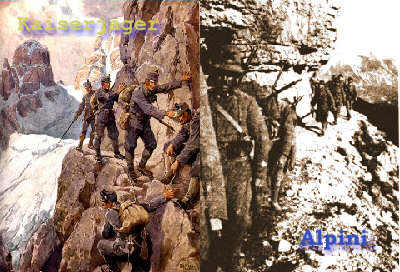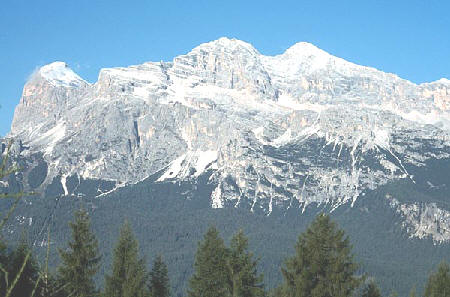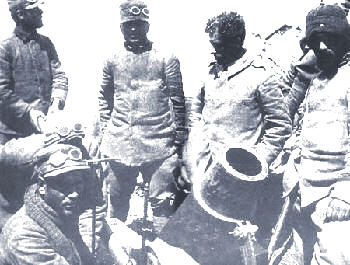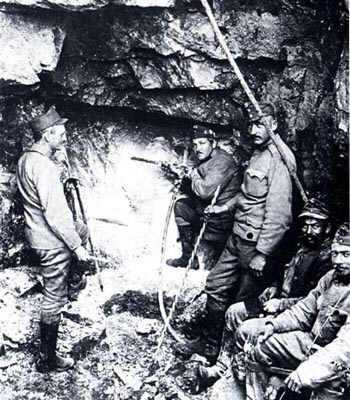
The Tofane Group, a magnificent blend of vertical rock and ice in the eastern Dolomite Mountains, was one of the major battlefields on the Italian Front in WW1. For the climber these three peaks are an endless challenge of cliff, ice-choked chimney and glacier. During La Grande Guerra these natural features and mountainous and year-round severe climate would provide limitless opportunities to ambush or delay the enemy. Infantry attacks took place on 45-degree rock slopes, often in howling blizzards.
Once the peaks were finally captured the war went underground, in a battle of tunneling and enormous exploding mines.

The Opponents Were Equally Vulnerable
As with all the highest summits on this border between the Austro-Hungarian Empire and Kingdom of Italy, the Austrians held the high ground. The only advantage the Italians had were numbers, as most of Franz Josef's army was battling [for their survival] in Russia. Cortina d'Ampezzo was captured within a month of the start of hostilities in May of 1915. As the town lies in the evening shadow of Tofane, the subsequent capture of the peak was imperative for the Italians. The ensuing battles for Tofane would witness peaks captured and lost, as the finest mountain troops of both nations, the Alpini and Kaiserjager, made vertical war on each other. Several battles pitted regiment against regiment, but just as deadly were the uncounted patrols meeting face to face. There were also several battalions of German Alpenkorps in this region of the Dolomites.
Despite the early tragedy of loosing their commanding General Cantore [to a headshot on 20 July 1915] the Italians advanced from the south and east up the Tofane massif. In August of 1915 the Alpini Belluno Battalion and attached units of Besaglieri [light infantry] captured the highest passes at Forcella Fontananegra. The next month, a company of volunteer Alpini from Feltre would capture the summits of Tofane di Rozes and the Tofane di Mezzo. By October the entire group was conquered, including the western summits of Tofane di Dentro and most of the nearby peak of Lagazuoi, beyond the initial mission. Except for two inaccessible Austrian outposts below lesser Tofane summits nicknamed Nemesis [finally captured 6 August 1916] and Schreckenstein [Terror Peak], the range was firmly in Italian hands.

The view from Cortina
[L-R] Tofane di Rozes [3225 m], Tofane di Mezzo [3244 m]
&
Tofane di Dentro [3238 m]
The value of the engineer corps was monumental here. By July of 1915 the Alpini had placed six mountain howitzers and two spotlights on the eastern summit of Tofane di Dentro. Daily teleferico runs increased the Italian defenses and supplies. The entire range was laced with trails cut into vertical cliffs, iron ladders and short tunnels through ridges- all able to rush men to critical places. Atop the western Tofane di Roces were two more cannons and a spotlight dug into solid rock.
With every Austrian or Italian move visible [and quickly targeted by MG or artillery,] the war now went underground with tunneling and mining. This second phase of warfare on Tofane is as amazing as the battle for ridge and summit. The first Austrian mine was detonated on New Years Day 1916 beneath the Italian observation post on Lagazuoi, a southern satellite peak of Tofane. Only 300 kilograms of explosives were used, but it was the first of many. On 17 April 1916 the Italians fired an enormous charge of five metric tons of dynamite [All tonnage is in metric tons, or 2,200 pounds] underneath nearby Col di Lana [See related article on the virtual tour.] Over one hundred Austrian troops were killed by the blast, many being suffocated by poisonous fumes. Another 150 were captured. The Schreckenstein was taken out with a blast and landslide. Thirty-five tons of explosives detonated at 3:20 AM on the 11th of July 1916 as the Italian King and General Cadorna observed. Over 150 Austrians were killed with hundreds more captured. The majority of these explosions however, were of a harassing nature, as either side's defenses had reached a deadly stalemate with towering cliffs, interlocking machinegun fire and supporting artillery. In comparison, the largest mines on the Western Front contained twenty tons of explosives. The war of nerves was just as deadly, however. Some men went insane listening to the boring others deserted. Miners in the trenches attempted to locate enemy tunnels to no avail.

Italian Mountain Mortar
Nature also contributed to the death toll in the Tofane range. In mid-December of 1916, a front wide snowstorm of record depth culminated in massive avalanches. The Austrian road in Valon Tofan north of Tofane was covered by a single slide of over four million cubic meters of snow, nearly a million tons. In places, over 18 meters of concrete-like snow covered this road. Miraculously, no convoys were on the road at the time, but in two days over 10,000 Italian and Austrian troops perished as a result of avalanches across the Dolomites.
The first "shot" of 1917's subterranean warfare was on the 14 January, when 16 tons of Austrian explosives were set of beneath Italian positions and trenches on Lagazuoi. The next explosion was May 22nd, again Austrian. Thirty tons of mining grade dynamite loosened 200,000 cubic meters of rock but incredibly it fell harmlessly away from Italian positions. On 20 June 1917 a 33-ton Italian mine was fired beneath the Austrian held west summit of Lagazuoi. Besides the death and destruction there, a landslide was set off on the west slope of the mountain that destroyed a lower Austrian observation post. The last mine in this region was detonated by the Austrians on the 16 September 1917 pictured at the top of the page], once again on Lagazuoi. Old tunnels were used to bring two tons of explosives above an Italian trail and barracks system. The burst released a well-aimed landslide of several thousand tons of rock onto the Italians. Hundreds of troops were killed by the rockslide and subsequent by artillery and machinegun fire.

Austrian Engineers Digging in Hard RockAs with almost all of the Dolomite Sector the end came with a whimper and not a bang. Italian troops withdrew from their hard won summits to shore up defenses in the lower peaks around the Piave during the collapse and subsequent defensive lines after Caporetto in late 1917. Today a cable car takes tourists from downtown Cortina to the central summit, to walk their dogs and eat lunch. There is an outstanding museum and restored tunnels at Lagazuoi. The climbing remains spectacular, and climbers on the sheer cliffs find shrapnel and cartridges, rusted pitons and tattered shreds of rope. During storms with lightening and 100 mph winds, modern climbers can only imagine military patrols in these conditions, out to kill each other or laying field telephone line or to recover a wounded comrade. Or a drilling noise from far below and coming closer....
|









